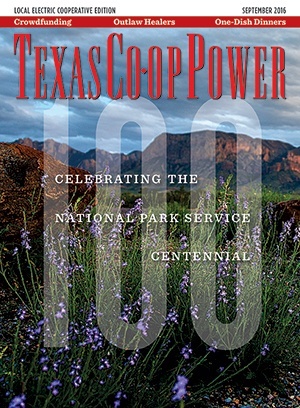Gregg Lewis-Qualls knew the board game business, and he also knew that as a graphic designer in Abilene, he was not necessarily the industry’s first choice to develop a new product.
“I had neither the ways, the means or the credit rating to produce a game,” says Lewis-Qualls, a soft-spoken and self-professed board game geek. “I didn’t have the connections, and I certainly didn’t know anyone in China who could produce and box and package the game.”
Rather than let his lack of resources stop him, Lewis-Qualls turned to online crowdfunding to raise a target $9,000 to publish a game called Outrider—think of it as Mad Max meets the Old West. In the end, he raised 250 percent of his goal ($22,500). In the process, he learned something that other Texans have discovered when raising money for causes as diverse as high school bands, medical bills and solar-powered cars.
When it works, crowdfunding, through websites such as Kickstarter, GoFundMe, Indiegogo and the University of Texas’ HornRaiser, can be a successful alternative for small businesses, individuals, nonprofits and even local governments seeking to fund a project without extensive application processes, credit reports, loans or grants. Often, crowdfunding is no more complicated than writing a simple business plan, shooting a short video and posting it online.
Crowdfunding matches well with the cooperative model and the cooperative values that have played an important role in Texas’ history. The notion of people chipping in to turn a lofty goal into reality is hardly new. About 80 years ago, groups of rural Texans joined together and asked their neighbors for $5 each to help everyone get electricity. The cooperatives that electrified the countryside are still in business—and still committed to making life better in their communities.
There are differences, of course, including legal requirements and accountability, which distinguish co-ops from crowdfunding efforts. But the underlying concepts are similar—a large group of people, each contributing one small part to the greater whole.
“You can see the analogy quite clearly,” says Martin Lowery, the executive vice president for member and associate relations for the National Rural Electric Cooperative Association. “It’s about how to get the meat on the bone for a project—that people put a great deal of work into their vision and that if people come together, they can make a great dream come true.”
The relationship is also apparent, Lowery says, in the way some food co-ops use crowdfunding to start operations, and in how community solar projects acquire land for solar panel arrays—asking members to subscribe to a specific project.
“That crowdfunding democratizes the process? That’s spot-on,” says John Terry, who teaches entrepreneurial management courses at Southern Methodist University in Dallas. “That’s what makes the process so attractive—the idea that I can participate, too, even if I don’t fit the profile.”
Online crowdfunding is relatively new. Kickstarter, probably the best known of the platforms, is only seven years old. But the concept has drawn tremendous attention for its ability to give people with ideas access to capital through the internet. The “idea people” can be writers, filmmakers, historical preservationists or entrepreneurs. In the crowdfunding process, there are no bankers or collateral. Plus, the entity doing the crowdfunding always owns 100 percent of the project; the crowdfunding sites take their cut through payment and processing fees. Some projects incentivize funding by offering rewards for backers, such as an advance copy of whatever is being funded, a mention in the credits or a piece of memorabilia. Once a project is funded, its owner can proceed without any other obligations.
That’s because projects are funded by raising small amounts of money from a large number of people who pledge not because they get a piece of the deal but because they think it’s a good idea—the cooperative concept taken into the 21st century. Outrider, the board game, had 263 contributors. Almost 3,000 people participated in a GoFundMe drive last fall to cover medical expenses for Caleb Luttrell of Waller. The Lewisville High School band collected $5,300 from 75 donors on YouCaring.
“I was able to strike a chord with the gaming community,” Lewis-Qualls says. “People in that community like direct access to creators.”
Crowdfunding may well be the postmodern version of the public television pledge drive—pledge a certain amount not because you want the gift that you might get for pledging, but because you believe in the idea of public television. And crowdfunding does the pledge drive one better because it has the ability to reach 200 million potential donors, thanks to the internet, Terry says.
“That’s one of the most interesting things about it,” he says, “that anyone with an idea worth funding can reach people who may be willing to fund the idea that they never would have been able to reach before. That allows for successes that may not be traditional.”
Crowdfunding has evolved since Kickstarter’s early days, when projects were more about technology and gadgets than anything else. Sites have been created for specific niches, such as PledgeCents and AdoptAClassroom for schools and education, while Fundable conducts small-business campaigns.
That niche approach was the basis for HornRaiser, says Marsha Reardon, student philanthropy and special campaign coordinator at the University of Texas. “We saw that UT students, faculty and employees were using external services, and we wanted to help them take control of what they were doing,” she says. “If it was a project related to UT, we wanted them to have the proper resources to do it successfully.”
This strategy has paid off, with a success rate between two-thirds and three-quarters for the dozen or so projects funded by HornRaiser twice a year. These include an effort last fall that garnered $22,070—$7,070 more than the goal—for the UT Solar Vehicles Team to build a solar-powered car called BeVolt.
However, UT’s success rate isn’t the norm. Crowdfunding projects fail to meet their need more often than not. Kickstarter’s success rate is 40 percent. Talk to people who have done it, even those who have been successful, and they’ll tell you that the road to their goal was much longer and much more difficult than they thought.
“I was very surprised at how little response I got,” says Charlie Brewer, an artist whose Kickstarter campaign to fund restoration of the historic Von Minden Manor in Fayette County yielded just eight backers and $485—a far cry from her $34,440 goal.
Some crowdfunding platforms allow solicitors to keep the money they’ve raised even if they don’t reach their goals. Kickstarter does not.
“When you start something like this, and you read the website and you see everyone who was successful,” Brewer says, “you really think there are a whole bunch of people out there who are going to want to give you money.”
For some, there are just enough.
“All I wanted to do when I started was to raise enough money to make a couple of hundred copies of the game with the board and the box,” Lewis-Qualls says. “But I wouldn’t have thought I would have been that successful in a million years. Needless to say, I was ecstatic.”
And why not? Cooperation goes a long way toward success.
——————–
Learn more about writer Jeff Siegel at winecurmudgeon.com.


